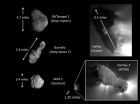(Press-News.org) COLUMBIA, Mo. ¬— Underage and heavy drinking on college campuses continue to be issues for college administrators. While some campuses, such as the University of Missouri, have made strides in efforts to reduce heavy drinking on campus, administrators are continually trying to educate students about the risks of excessive drinking. Now, two MU psychologists have found that students who viewed images of beer cans packaged and displayed in university colors believed that drinking beer was less dangerous than those students who saw images of regular beer cans.
"In this research, we wanted to determine if certain marketing strategies had an effect on whether individuals felt that a certain behavior – in this case, drinking beer – was more or less dangerous," said Chris Loersch, a post-doctoral fellow in the Department of Psychological Sciences in the MU College of Arts and Science. "We found that when people identify themselves with a certain group, such as a college or university, and if that group 'endorses' a product, people assume the product is safe."
According to Loersch, previous studies had investigated how belonging to social groups can affect the behaviors or perceptions of individuals. Loersch said that groups can be close-knit, such as family relationships, or they can be broader, such as individuals who all attend the same university. In either case, people tend to feel a sense of trust and safety within their own groups, or what psychologists call "ingroups."
In the study, Loersch and Bruce Bartholow, associate professor of psychological sciences at MU, found that undergraduate participants who were briefly exposed to beer packaged in MU colors perceived beer drinking as safer than did participants who had seen images of standard beer cans. These feelings of safety existed even when participants were subliminally exposed to the word "beer," providing evidence that the fan cans affect people's unconscious responses toward beer. Loersch said that this research did not investigate whether this change affected actual drinking behavior.
"Previous research has consistently demonstrated that people view members of their social groups as trustworthy and safe," Loersch said. "Our research indicates that this sense of interpersonal safety for ingroup members appears to extend to a product that, via its packaging, conveys cues for group affiliation. These results are important given that alcohol consumption is associated with unsafe behavior, often leading to increases in risk-taking, aggressiveness and likelihood of serious injury."
In the research, Loersch and Bartholow conducted three experiments. University of Missouri students were randomly assigned to view either a standard beer can or a fan can with MU colors along with other beverages. Participants in the first experiment rated beer consumption as less dangerous after having seen the fan can compared to the regular beer can. In the second experiment, participants who first saw the fan can were faster to recognize words indicating safety, and slower to recognize words indicating danger, than were participants who first saw a regular beer can. In the third experiment, participants who saw a fan can rated the local social scene as less dangerous compared to participants who saw a regular beer can or a bottle of water presented in university colors.
"Evidence-based prevention strategies focus on helping students accurately assess the risks associated with drinking," said Susan O'Neill, a psychologist with the MU Student Health Center. "Marketing campaigns that alter drinkers' perceptions of alcohol's potential risks -- particularly at an automatic or unconscious level -- have no place in college communities. Challenging the aggressive promotion of drinking, whether by campus social groups or national corporations, is important to create a campus culture that encourages responsible drinking."
INFORMATION:
The study was published recently in the Journal of Experimental Social Psychology.
Team colors on cans change perceptions of alcohol risks, MU study finds
University of Missouri psychologists find that participants exposed to 'fan cans' find beer consumption less dangerous
2010-11-11
ELSE PRESS RELEASES FROM THIS DATE:
University of Minnesota leads team in discovery of novel type of magnetic wave
2010-11-11
A team of international researchers led by physicists in the University of Minnesota's College of Science and Engineering have made a significant breakthrough in an effort to understand the phenomenon of high-temperature superconductivity in complex copper-oxides—one of the most studied scientific topics in history.
The University of Minnesota researchers and their international colleagues from Germany, France and China report the discovery of a novel type of magnetic wave involving oxygen atoms. The new findings could have implications for improving superconducting ...
NIH scientists unveil mechanisms of immune reconstitution inflammatory syndrome
2010-11-11
WHAT:
Newly published research by scientists at the National Institute of Allergy and Infectious Diseases, part of the National Institutes of Health, sheds light on a poorly understood, acute illness called Immune Reconstitution Inflammatory Syndrome (IRIS) that develops in some HIV-infected individuals soon after they begin antiretroviral therapy.
IRIS affects certain HIV-infected individuals whose immune systems are heavily damaged by the virus and who have a treated or undiagnosed AIDS-associated infection. When these individuals start antiretroviral therapy and ...
Cassini's CIRS reveals Saturn is on a cosmic dimmer switch
2010-11-11
Like a cosmic light bulb on a dimmer switch, Saturn emitted gradually less energy each year from 2005 to 2009, according to observations by NASA's Cassini spacecraft.
But unlike an ordinary bulb, Saturn's southern hemisphere consistently emitted more energy than its northern one. On top of that, energy levels changed with the seasons and differed from the last time a spacecraft visited in the early 1980s. These never-before-seen trends came from an analysis of comprehensive data from the Composite Infrared Spectrometer (CIRS), an instrument built by NASA's Goddard Space ...
Primordial dry ice fuels comet jets
2010-11-11
COLLEGE PARK, Md. – One of the biggest comet findings coming out of the amazing images and data taken by the University of Maryland-led EPOXI mission as it zipped past comet Hartley 2 last week is that dry ice is the 'jet' fuel for this comet and perhaps many others.
Images from the flyby show spectacular jets of gas and particles bursting from many distinct spots on the surface of the comet. This is the first time images of a comet have been sharp enough to allow scientists to link jets of dust and gas with specific surface features. Analysis of the spectral signatures ...
Pleasurable behaviors reduce stress via brain pathways, research shows
2010-11-11
CINCINNATI—Whether it's food or sex, pleasurable activity provides more than just pleasure, University of Cincinnati (UC) researchers say. It actually reduces stress by inhibiting anxiety responses in the brain.
The findings were published online Nov. 8, 2010, ahead of print in PNAS, the official journal of the National Academy of Sciences.
Experiments designed by Yvonne Ulrich-Lai, PhD, research assistant professor, James Herman, PhD, director of the Laboratory of Stress Neurobiology and professor of psychiatry and behavioral neuroscience at UC, and colleagues also ...
Economists reveal factors that help poor people lift themselves out of poverty
2010-11-11
What factors contribute to poor people in developing countries lifting themselves out of poverty?
A paper by economists Anan Pawasutipaisit of Thammasat University and Robert M. Townsend of MIT provides important insights into what kinds of households might be most effective at moving themselves out of poverty and how they are able do it.
The paper, "Wealth Accumulation and Factors Accounting for Success" appears in the current issue of the Journal of Econometrics. It suggests that poor people who skillfully manage their assets are especially successful in improving ...
Noninvasive brain stimulation helps improve motor function in stroke patients
2010-11-11
BOSTON -- A noninvasive electric stimulation technique administered to both sides of the brain can help stroke patients who have lost motor skills in their hands and arms, according to a new study led by researchers at Beth Israel Deaconess Medical Center (BIDMC).
Described in today's Online Issue of the journal Neurology, the findings showed that stroke patients who received bihemispheric transcranial direct current stimulation (tDCS) coupled with a regimen of physical and occupational therapy had a three-fold greater improvement in motor function compared with patients ...
JDRF clinical panel recommends next steps for artificial pancreas clinical testing
2010-11-11
Diabetes experts at a meeting convened by the U.S. Food and Drug Administration (FDA) and the National Institutes of Health (NIH) took the next step in advancing efforts toward the development of an artificial pancreas: putting forth clinical recommendations to ensure the safe and effective testing of artificial pancreas technology in real-life situations. We are pleased at today's meeting there was a strong consensus among leading clinicians, researchers and industry leaders regarding the path toward outpatient studies for both low-glucose suspend and artificial pancreas ...
Win some, lose some: U-M expert provides reapportionment projections
2010-11-11
ANN ARBOR, Mich.---Before the U.S. Census Bureau releases its official state-level population counts to Congress on Dec. 31, a University of Michigan demographer offers projections of likely state winners and losers.
But she also cautions that there are likely to be plenty of surprises.
According to Lisa Neidert, data services manager at the U-M Institute for Social Research (ISR) Population Studies Center, the most likely state winners---based on July 2009 population estimates from the Census Bureau---are Texas (3 seats), and Arizona, Florida, Georgia, Nevada, South ...
New forms of highly efficient, flexible nanogenerator technology
2010-11-11
Can a heart implanted micro robot operate permanently? Can cell phones and tiny robots implanted in the heart operate permanently without having their batteries charged?
It might sound like science fiction, but these things seem to be possible in the near future.
The team of Prof. Keon Jae Lee (KAIST, Dept. of Materials Science and Engineering) and Prof. Zhong Lin Wang (Georgia Institute of Technology, Dept. of Materials Science and Engineering) has developed new forms of highly efficient, flexible nanogenerator technology using the freely bendable piezoelectric ceramic ...
LAST 30 PRESS RELEASES:
JULAC and Taylor & Francis sign open access agreement to boost the impact of Hong Kong research
Protecting older male athletes’ heart health
KAIST proposes AI-driven strategy to solve long-standing mystery of gene function
Eye for trouble: Automated counting for chromosome issues under the microscope
The vast majority of US rivers lack any protections from human activities, new research finds
Ultrasound-responsive in situ antigen "nanocatchers" open a new paradigm for personalized tumor immunotherapy
Environmental “superbugs” in our rivers and soils: new one health review warns of growing antimicrobial resistance crisis
Triple threat in greenhouse farming: how heavy metals, microplastics, and antibiotic resistance genes unite to challenge sustainable food production
Earthworms turn manure into a powerful tool against antibiotic resistance
AI turns water into an early warning network for hidden biological pollutants
Hidden hotspots on “green” plastics: biodegradable and conventional plastics shape very different antibiotic resistance risks in river microbiomes
Engineered biochar enzyme system clears toxic phenolic acids and restores pepper seed germination in continuous cropping soils
Retail therapy fail? Online shopping linked to stress, says study
How well-meaning allies can increase stress for marginalized people
Commercially viable biomanufacturing: designer yeast turns sugar into lucrative chemical 3-HP
Control valve discovered in gut’s plumbing system
George Mason University leads phase 2 clinical trial for pill to help maintain weight loss after GLP-1s
Hop to it: research from Shedd Aquarium tracks conch movement to set new conservation guidance
Weight loss drugs and bariatric surgery improve the body’s fat ‘balance:’ study
The Age of Fishes began with mass death
TB harnesses part of immune defense system to cause infection
Important new source of oxidation in the atmosphere found
A tug-of-war explains a decades-old question about how bacteria swim
Strengthened immune defense against cancer
Engineering the development of the pancreas
The Journal of Nuclear Medicine ahead-of-print tip sheet: Jan. 9, 2026
Mount Sinai researchers help create largest immune cell atlas of bone marrow in multiple myeloma patients
Why it is so hard to get started on an unpleasant task: Scientists identify a “motivation brake”
Body composition changes after bariatric surgery or treatment with GLP-1 receptor agonists
Targeted regulation of abortion providers laws and pregnancies conceived through fertility treatment
[Press-News.org] Team colors on cans change perceptions of alcohol risks, MU study findsUniversity of Missouri psychologists find that participants exposed to 'fan cans' find beer consumption less dangerous


